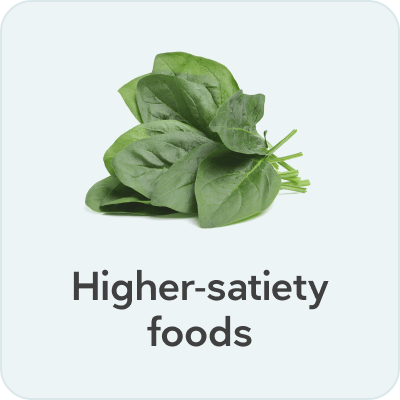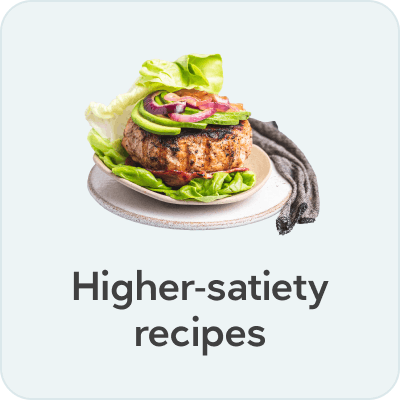Troubleshooting higher-satiety eating
Evidence based
Are you wondering if higher-satiety eating is the right approach for you? Are you worried you will find it too difficult to stick to or to fit into your life? Or perhaps you have started focusing on a higher-satiety approach but are encountering some challenges?
Like so many things in life, getting the details right matters. We believe that if you dial in higher-satiety eating to suit your particular needs, you’ll have an excellent chance of success.
Of course, no one dietary approach suits all eaters. But using satiety to guide your food choices is a science-based way to maximize your chance of losing weight and improving your health.
In this guide, we’ll help you fine-tune your food choices so you can give higher-satiety eating the best chance of working.


Carb creep
Carb creep is the term used when more and more carbs slip back into your diet without you realizing it. This may be especially concerning for those with insulin resistance who may do better with low carb eating.
A higher-satiety diet is compatible with many different diets, from keto to high carb diets. But eating food based on satiety score alone doesn’t take into account the hormonal effect food may have. However, hormonal responses to food, especially insulin response, may differ from person to person, particularly when it comes to higher carb diets.
If you have type 2 diabetes, prediabetes, or insulin resistance, you may want to try starting with a low carb, high-satiety approach. Start with high-satiety keto for the fastest and most effective option, with less than 20 grams of net carbs per day. Or, for a little more variety, start with a moderate low carb, high-satiety approach.
If you aren’t sure whether you have insulin resistance or if you can tolerate carbs well, please see our educational guides What you need to know about insulin resistance and What’s your carb tolerance?
Too hungry
Higher-satiety eating sometimes leads to lowering both fat and carbs. For some, that may result in healthy weight loss, but for others, it may lead to eating too few calories and increased hunger.
Since higher-satiety eating favors eating plenty of protein and fibrous vegetables, it is rare that eating too little protein and vegetables is the cause of hunger when implementing this approach. Instead, you may want to try increasing fat or carb intake — but try not to increase both fat and carbs, as that leads to higher calorie, low-satiety eating.
You can try eating 10% carbs, 30% protein, and 60% fat, or, if you prefer a lower fat approach, you can try 40% carbs, 30% protein, and 30% fat.
You can also address hunger by snacking.
I know, I know. We’ve said many times that eliminating snacking is a good goal for healthy weight loss. But choosing the right snacks — high protein snacks — and snacking for the right reason — snacking to alleviate hunger, not out of boredom or routine — can sometimes solve hunger issues while still allowing you to lose weight and improve your metabolic health.
What are the best high protein snacks? Check out our guide 21 high protein snacks, ranked.
Eating carbs and fat together
One principle of eating for satiety is that there aren’t absolute good and bad foods. Instead, foods are higher satiety or lower satiety. That principle can sometimes open the door for people to eat low-satiety, high calorie, processed foods that combine carbs and fat. Think doughnuts, pizza, and cookies.
Some people may succeed in eating higher-satiety foods and adding a few high calorie foods combining carbs and fat. However, others may struggle to stop at just one cookie or may have a surge in cravings when they eat pizza or chips.
If you find yourself in the latter group, as many of us do, you’re likely better off limiting foods that combine carbs and fat. Instead, focus on whole foods that are mostly protein and decide if you want to add carbs or fat, but not both, to your higher-satiety meal plan.
And, if you’re afraid you may miss your pizza, cheese bread, ice cream, etc. fear not! We have low-carb replacement versions of all your favorites that add fat, but not fat and carbs together.
Not enjoying your meals
We get it. Food isn’t all about health and weight loss. It’s important to enjoy your meals, look forward to eating, and finish your meal feeling satisfied — physically and emotionally.
Sometimes eating higher-satiety foods can lead to feelings of monotony, boredom, and dissatisfaction. But it doesn’t have to be that way.
Here are some tips to increase your food enjoyment
- Decrease your target satiety score. Not happy with an average score of 50? That’s OK. Try 40. You may enjoy your meals with a greater variety of foods while still progressing with healthy weight loss.
- Search out different textures. Processed food companies talk about “mouth feel” and hitting the right textures of food to get you hooked on their products. They know that we are hardwired to enjoy crunchy, crispy, and salty foods. But that doesn’t mean these textures are inherently bad.
Instead, try some of our favorite crunchy and crispy alternatives like our keto seed crackers, taco shells, crispy garlic bread, or parmesan crisps. And, feel free to add salt to improve the tastiness of your food! You can read more about the health effects of salt in our evidence-based guide.
- Add more spices or flavor. You have many options — sharp, tangy, spicy, hot, and even umami flavors! A small piece of sharp blue cheese can make a plain salad more satisfying.
You aren’t hungry but feel like you “should” eat with your family
Sometimes eating higher-satiety foods works a little too well. You may feel so satiated after lunch that you have little interest in eating dinner. But if dinner is your family meal, you may sit down and eat anyway since it feels like the ”right” thing to do. That adds calories your body doesn’t need.
An important principle of higher-satiety eating is that you shouldn’t eat if you aren’t hungry. Yet eating meals together as a family has been shown to have positive impacts on childhood learning, behaviors, family relationships, and modeling healthy eating patterns.
If that’s the case, consider eating a smaller lunch so you can “save” your larger, higher-satiety meal for dinner with your family. A happy home and positive relationships to food and to each other at the dinner table are likely to help you succeed in the long run.
Don’t forget non-food lifestyle choices
Your food choices may be the most important decisions for healthy weight loss, but food isn’t the only thing that matters.
Getting enough quality sleep, being physically active, and managing chronic stress are all imperative for healthy weight loss. Eating well doesn’t give you a “free pass” regarding these non-food lifestyle choices.
Want to improve your sleep? Try going to bed and waking up at the same time every day — even on the weekends. Avoid drinking caffeine after noon, and put away all screens — yes, even your phone — at least an hour before bedtime.
Wondering what the right kind of exercise is for you? The short answer is whatever you enjoy and will maintain long term! You can read our evidence-based guide on exercise and health for more detailed information.
Are you looking for ways to reduce your chronic stress? Try starting a regular mindfulness or meditation practice. You don’t have to do much. Even 10 minutes a day may be enough to see physical and psychological benefits.





